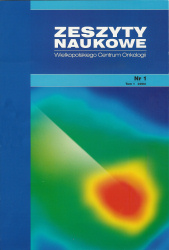Abstrakt
Telomeraza to duży, złożony kompleks enzymatyczny, który odpowiada za proces syntezy telomerów budujących zakończenia eukariotycznych chromosomów. Podwyższona ekspresja genu kodującego katalityczną podjednostkę tego enzymu – hTERT – jest obserwowana w około 88% przypadków nowotworów rejonu głowy i szyi. Komórki rakowe zyskują wówczas wysoki potencjał replikacyjny, a także zdolność do unikania apoptozy. Zahamowanie aktywności telomerazy w terapii przeciwnowotworowej stało się priorytetem badań naukowych już kilkanaście lat temu. Istnieją różne metody wykorzystujące obniżenie ekspresji telomerazy, od terapii genowej do wykorzystania przeciwutleniaczy. Pomimo wielu danych zebranych w ostatnich latach pojawia się coraz więcej pytań w odniesieniu do roli telomerazy w powstawaniu raka. Należy przeprowadzić więcej szczegółowych badań w celu zrozumienia udziału tego enzymu w procesie rozwoju nowotworu w obrębie narządów głowy i szyi. Celem niniejszego artykułu jest zebranie dotychczasowej wiedzy na temat zastosowania telomerazy w terapii onkologicznej.
Bibliografia
Méry B, Guy JB, Espenel S, Wozny AS, Simonet S, Vallard A, et al. Targeting head and neck tumoral stem cells: From biological aspects to therapeutic perspectives. World J Stem Cells. 2016;8(1):13-21. doi: 10.4252/wjsc.v8.i1.13.
Polskie Towarzystwo Onkologiczne. Obecny Stan Zwalczania Nowotworów
w Polsce. 16 maja 2014 roku.
Haines GK (2013) Pathology of Head and Neck Cancers I: Epithelial and Related Tumors. In: Radosevich JA (ed). Head and Neck Cancer: Current Perspectives, Advances and Challenges. Springer Science & Business Media, Dordrecht, pp:257-87.
Klein JD, Grandis JR. The molecular pathogenesis of head and neck cancer. Cancer Biol Ther. 2010;9(1):1-7.
Prince ME, Sivanandan R, Kaczorowski A, Wolf GT, Kaplan MJ, Dalerba P, et al. Identification of a subpopulation of cells with cancer stem cell properties in head and neck squamous cell carcinoma. Proc Natl Acad Sci USA. 2007;104: 973-978.
Wicha MS, Liu S, Dontu G. Cancer stem cells: an old idea-a paradigm shift. Cancer Res. 2006;66: 1883-1890.
Pfeiffer V, Lingner J. Replication of telomeres and the regulation of telomerase. Cold Spring Harb Perspect Biol. 2013;5(5): a010405.
Masood A. Shammas. Telomeres, lifestyle, cancer and aging. Curr. Opin. Clin. Nutr. Metab Care. 2011;14(1):18-34.
Sandin S, Rhodes D. Telomerase structure. Curr Opin Struct Biol. 2014;25(100):104-110.
Lu W, Zhang Y, Liu D, Songyang Z, Wan M. Telomeres-structure, function, and regulation. Exp Cell Res. 2013; 319(2):133-41.
de Lange T. How telomeres solve the end-protection problem. Science. 2009;326:948–952.
Greider C.W., Blackburn E.H. Identification of a specific telomere terminal transferase activity in Tetrahymena extracts. Cell. 1985;43:405–413.
Cesare AJ, Reddel RR. Alternative lengthening of telomeres: models, mechanisms and implications. Nat Rev Genet. 2010;11(5):319-30. doi: 10.1038/nrg2763.
Kunická Z, Mucha I, Fajkus J. Telomerase activity in head and neck cancer. Anticancer Res. 2008;28(5B):3125-9.
Forastiere A, Koch W, Trotti A, Sidransky D. Head and neck cancer. N Engl J Med. 2001;345:1890-1900.
Choong N, Vokes E. Expanding role of the medical oncologist in the management of head and neck cancer. CA Cancer J Clin. 2008;58:32-53.
Kanazawa T, Misawa K, Misawa Y, Uehara T, Fukushima H, Kusaka G, et al. G-protein-coupled receptors: Next generation therapeutic targets in head and neck cancer? Toxins (Basel). 2015;7:2959-2984.
Kelland LR. Overcoming the immortality of tumour cells by telomere and telomerase based cancer therapeutics--current status and future prospects. Eur J Cancer. 2005;41(7):971-9.
Mocellin S, Pooley KA, Nitti D. Telomerase and the search for the end of cancer. Trends Mol Med. 2013;19:125–133. doi:10.1016/j. molmed.2012.11.006.
Vinagre J, Pinto V, Celestino R, Reis M, Pópulo H, Boaventura P, et al. Telomerase promoter mutations in cancer: an emerging molecular biomarker? Virchows Arch. 2014;465:119–133. doi: 10.1007/s00428-014-1608-4
Damm K, Hemmann U, Garin-Chesa P, Hauel N, Kauffmann I, Priepke H, et al. A highly selective telomerase inhibitor limiting human cancer cell proliferation. EMBO J. 2001;20:6958–6968. doi:10. 1093/emboj/20.24.6958.
Buseman CM, Wright WE, Shay JW. Is telomerase a viable target in cancer? Mutat Res. 2012;730:90–97.
Li P, Wu M, Wang J, Sui Y, Liu S, Shi D. NAC selectively inhibit cancer telomerase activity: A higher redox homeostasis threshold exists in cancer cells. Redox Biol. 2015;8:91-97. doi: 10.1016/j.redox.2015.12.001.
Venteicher AS, Artandi SE. TCAB1: driving telomerase to Cajal bodies. Cell Cycle. 2009;8(9):1329-31.
Sun CK, Luo XB, Gou YP, Hu L, Wang K, Li C, et al. TCAB1: a potential target for diagnosis and therapy of head and neck carcinomas. Mol Cancer. 2014;13:180. doi: 10.1186/1476-4598-13-180.
Zhao YQ, Feng HW, Jia T, Chen XM, Zhang H, Xu AT, et al. Antiproliferative effects of celecoxib in Hep-2 cells through telomerase inhibition and induction of apoptosis. Asian Pac J Cancer Prev. 2014;15(12):4919-23.
Li J, Lei H, Xu Y, Tao ZZ. miR-512-5p suppresses tumor growth by targeting hTERT in telomerase positive head and neck squamous cell carcinoma in vitro and in vivo. PLoS One. 2015;10(8):e0135265. doi: 10.1371/journal.pone.0135265.
Chiang KC, Yeh CN, Hsu JT, Chen LW, Kuo SF, Sun CC, et al. MART-10, a novel vitamin D analog, inhibits head and neck squamous carcinoma cells growth through cell cycle arrest at G0/G1 with upregulation of p21 and p27 and downregulation of telomerase. J Steroid Biochem Mol Biol. 2013;138:427-34. doi: 10.1016/j.jsbmb.2013.09.002.
Takahashi H, Hyakusoku H, Horii C, Takahashi M, Nishimura G, Taguchi T, et al. Telomerase-specific oncolytic adenovirus: antitumor effects on radiation-resistant head and neck squamous cell carcinoma cells. Head Neck. 2014;36(3):411-8. doi: 10.1002/hed.23309.
Waghorn PA, Jackson MR, Gouverneur V, Vallis KA. Targeting telomerase with radiolabeled inhibitors. Eur J Med Chem. 2017;125:117-129. doi: 10.1016/j.ejmech.2016.09.028.
Zhao T, Hu F, Liu X, Tao Q. Blockade of telomerase reverse transcriptase enhances chemosensitivity in head and neck cancers through inhibition of AKT/ERK signaling pathways. Oncotarget. 2015;6(34):35908-21. doi: 10.18632/oncotarget.5468.
